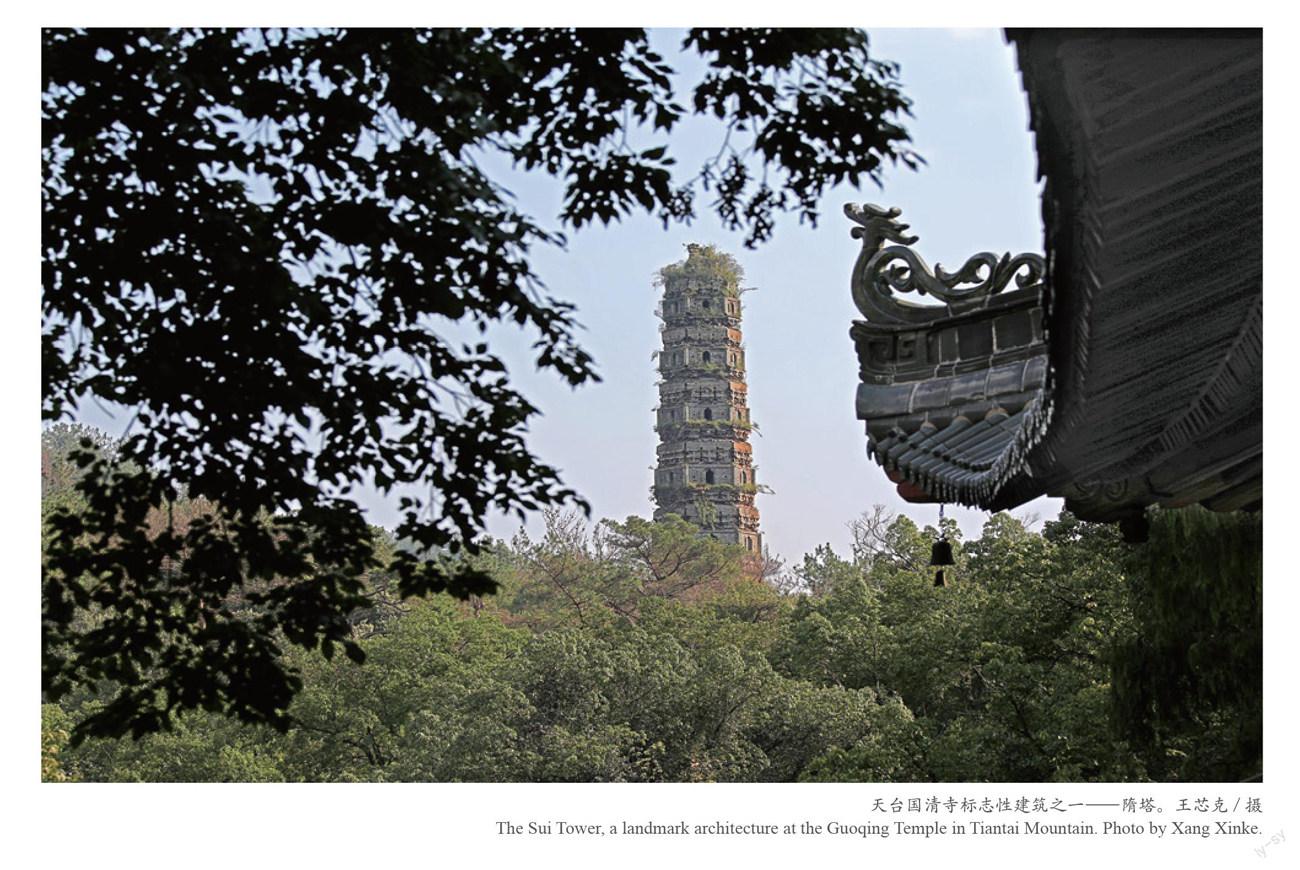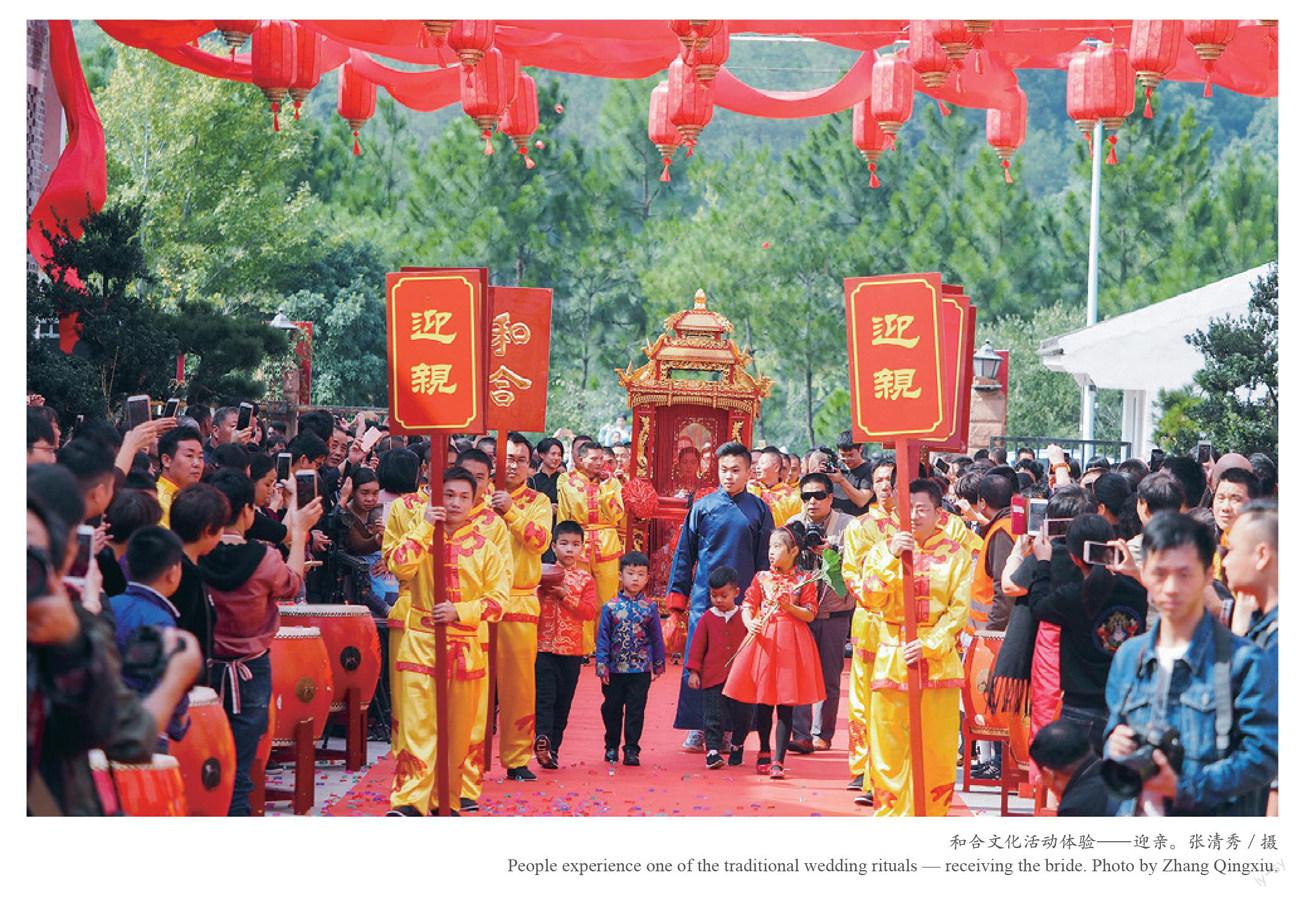和合传播走向世界
2022-05-30卢珍珍王佳丽
卢珍珍 王佳丽



和合文化既是历史的,又是当代的;既是中国的,又是世界的。近几年来,各地都在重新梳理、研究和合文化,以此来更好地弘扬、传播和合精神,服务社会。
在浙江台州,《台州市“和合圣地”建设行动纲要》将和合文化的建设和发展提升到新的高度:到2030年,和合文化将根植于台州,与城市深入融合,其传播力、影响力将更加广泛深远,让台州真正成为中华和合文化的标志地、传播地、示范地,成为享誉中外的“和合圣地”。
和合研究 深化当代价值
和合文化正在润物细无声地融入台州的文化基因。它是一种看得见、摸得着的文化形态之存在。多年来,为了让和合文化传播得更远,各方一直在努力。
理论是文化传承的基础。
2017年3月,浙江省启动了第二期文化研究工程,台州“和合文化”被选入其中,也是全省唯一地级市课题。“天台山和合文化”的概念、形成、发展、传承等,是当时课题的研究重点。
为了确保研究的深入性和持续性,2017年5月,台州学院和合文化研究院挂牌成立。
同年年底,由台州市编著的《解读和合文化》正式出版。這本书从台州的历史文化出发解读和合文化,既有学理的高度,又有历史的深度。
中华和合文化有三大源头,即龙图腾文化、三祖文化以及天台山文化。《解读和合文化》对三个源头进行了概要性的介绍,并对天台山文化进行了细致和深入的梳理。
事实上,关于天台山文化的研究,台州做得很早。
早在1989年5月18日,台州市天台山文化研究会成立,它是国内首家市级研究名山文化的群众性学术团体。为了挖掘和弘扬天台山文化,据不完全统计,研究会列入国家级规划课题7项、省部级规划课题20多项、市厅级规划课题50多项。1993年以来,研究会开展各类大小文化研讨交流活动数百次。
在一次又一次的研讨交流活动中,和合文化的内涵与价值被广泛传播。
2008年5月,中国社科院世界宗教研究所、浙江省社科联等联合举办了“寒山子暨和合文化国际研讨会”,来自11个国家和地区的130多位专家学者与会。
2017年11月,天台举办以“尚和合,求大同”为主题的天台山和合文化论坛,来自中国、美国、日本、韩国、泰国等国家的近200名专家学者参会。
会上,学者们探讨了和合文化在“一带一路”建设和构建人类命运共同体中的作用,更好地促进了传统文化与地域经济的相互融合。来自国内外各界的专家学者,分享了对和合文化的新见解、新思路。会后,“和合圣地”之碑被立在天台。
2019年10月,台州“文化融”主题峰会暨天台山和合文化论坛在天台举行,深入探讨了和合文化的当代价值。
和合传播 影响走向世界
一首诗、一个形象、一种思想,这些是历史上和合文化对外输出的最初载体。
寒山子及其诗歌对中国哲学、诗歌、小说、书画艺术、民间建筑、民间信仰等都产生了深远的影响,其影响还走向了世界。
在日本,无处不寒山,寒山诗和他的传说,在北宋神宗年间传入日本。寒山子对日本的文学、美术、音乐等产生了重要影响,寒山子的思想、形象更是渗透到日本人的生活之中。在日本,我们到处可见寒山邮票、寒山墨块、寒山刀等。
20世纪50年代,伴随着禅宗的传播,寒山诗及其形象从日本传到了美国,此后,形成了历时近20年之久的“寒山热”,影响了很多美国读者和文学家。
如今,在多方努力下,和合文化走向海外,有了更多的传播土壤和途径。
2018年10月中旬,在枫叶之国成立了加拿大中国和合文化研究会。
加拿大中国和合文化研究会创会会长、天台人王典奇表示,加拿大的文化,实际上就是一种和合文化,大家和衷共济、和合共生。因此,加拿大和中国有着共同的“和合”文化基因,成立加拿大中国和合文化研究会,可以说是时机成熟,水到渠成。
王典奇说,“和合”是一种文化,更是一种文明,是一种趋势。古今中外,任何一个家庭的幸福、企业的成功、国家的繁荣,都离不开“和合”二字。成立“和合文化研究会”就是要梳理和合文化发展脉络,研究和合文化当代价值,将这一“东方智慧”推广到加拿大,在现实生活中科学理解和正确弘扬中华和合文化,为中国的和合文化与加拿大的多元文化相互交流融合作出贡献。
郑燕是土生土长的天台人,现任日本台州同乡会常务副会长。
2019年7月9日下午,中国第一家海外天台山和合文化驿站的授牌仪式在日本东京举行。郑燕代表日本台州同乡会接牌。
郑燕说,以前在国内时并不知道天台与日本的关系,到日本后才知道,家乡竟然与日本有如此深厚的渊源。儒、道、释三教融通的和合文化,不仅是天台的、中国的,更是世界的。天台山和合文化东京驿站,架起了中日文化交流的桥梁,将让更多的日本民众了解和合文化。
和合体验 共享特色文化
和合文化的传播,它并不局限在空间范畴,它是多维度的。
2018年8月,旅游演艺歌舞剧《天台遇仙记》在天台指向艺术中心音乐剧场举行了首演。
《天台遇仙记》改编自天台的一则民间传说“刘阮遇仙”,讲述刘晨、阮肇入天台山采乌药,因迷路而误入桃源,与两位仙女结为伉俪的爱情故事。
除了保留原故事的浪漫爱情之外,该剧还加入了很多天台元素和和合文化元素,旨在弘扬天台本土文化,弘扬和合文化,成为天台对外宣传的一张金名片。
和合文化可以通过眼睛看,也可以去进行沉浸式体验。
来天台之前,你可以在微信上关注“天台度过”,它是一家以天台山文化旅游、休闲养生推广为品牌特色的综合性文化体验平台,也是天台山优秀传统文化研学旅行基地。
传统手工、植物扎染、禅修养生……关于和合文化的沉浸式体验,这里已经举办了上千场。
天台还推出了和合雅集,它是将地方人文历史和旅游文化元素浓缩在一起展现给游客的雅集,是国内外游客体验天台山文化最直接、感受最深刻的文化体验传播活动。
济公,是天台历史上典型的和合文化人物。这几年,关于济公形象的优质动画输出,让更多人知道了天台,知道了和合文化。
与央视动画公司合作创作的电视动画片《小济公》,被评为“国家走出去翻译工程重点项目”,获得中国文化艺术政府奖第三届“最佳动漫作品奖”、浙江省第十三届精神文明建设“五个一工程奖”等。
动画大电影《济公之降龙降世》,讲述了由降龙罗汉转世的少年李修缘在历经人间苦难后,再次悟道重获金身,肩负使命拯救苍生的故事。电影在全国公映后收到了广泛好评,该电影还入围第34届中国金鸡百花电影节最佳美术片提名名单。
和合传承 融入人们生活
走进台州市博物馆,正在临展的《和合系列——和合圆融》雕塑作品,不仅展现了台州民间工艺美术的精湛,更体现和合文化的深刻内涵;漫步和合公园,市民在观鸟听溪中享受城市慢生活,感受人、建筑、自然的和谐之韵;穿过黄岩“七十二巷”,作为“和合街区”创建的实践点,老巷呈現出“新旧共生、和而不同”的城市新风貌……
和合文化,千年传承,台州早已将其融入自身发展的血液之中,“和合圣地”成为台州的城市新定位。从学校到社区,从集体生活、私人生活到除家庭单位之外的“第三生活”,和合文化以鲜活的文化形态扎根台州,与城市深度融合。
来到天台,这里的地标都很“和合”。从和合文化公园和合二仙大型铜雕,到高速出口小济公大型铜雕,城市景观雕塑以其独有的造型方式和巧妙的空间语言,凝聚群众的文化共识,展现城市性格。一座和合小镇,是和合文化展示和传播的新高地。小镇的核心之一——和合文化创意街区,以和合文化为主题,融入丰富和合文化创意项目,集休闲旅游、文化创意、健康服务于一体。
已建成的龙溪和合文化研学基地、后岸和合文化旅游特色村、始丰湖公园和合文化广场等一批物化工程,都是“和合地标”建设的崭新图景。此外,天台县还在抓紧寒山古城、唐诗小镇等一批重大项目建设。
以和合文化为主题的地标建筑拔地而起,以和合精神为指导的文化场馆也落地生根。这些场馆不仅是用来“打卡”的,更是群众文化滋养、自我提升的精神家园。
同样,一批批和合书院、和合讲堂落地建成,用于举办各类文化和读书活动,成为有温度、有质感的精神文明体验场景。位于天台县张思古村的宗渊书院,毗邻天台山桐柏宫的琼台书院,面向全民推行“传统国学”与“和合文化”的广泛学习;路桥区坦田村的映雪书院,邵家渡中心校的尚斌书院等,融合当地文化记忆,成为百姓开展阅读与文化活动的重要载体。
为让和合文化传承下去,天台县举办第三届“少年非遗说”传说故事讲述大赛,上千名学生参与报名。孩子们用讲故事的方式,为一段段悠远的历史——刘阮传说、寒山拾得传说、智者大师故事、国清寺古迹等注入新的活力,让民间文学在得到更广泛传播的同时,推动非遗文化的传承与保护。
在天台,除了关注学生“和合品格”的养成外,还聚焦教师“和合素养”的培育。天台县教师进修学校举办中国传统文化和天台和合文化培训班,有近百名教师参加培训。教师通过多角度多层面的分析解读,深入学习和感悟天台山和合文化,激发爱乡热情,自发成为和合文化的宣传员。
更深刻的文化研究和理论归纳,须将目光重新投射至校园。近年来,台州学院深化和合理论研究,阐发和合文化精髓,成立天台山文化研究院、和合文化研究院、唐诗之路研究院等,成功获批省部级以上文化研究项目13项,出版学术著作近10部,并通过联合台州市社联和天台县和合文化研究组,开展各类课题研究,举办全国性文化论坛等,已初步形成和合文化理论体系建设。
和合理念 渗透社会治理
近年来,天台县将“和合理念”渗透到社会治理各个方面,广泛开展“和合文化六进活动”,在工作中凝聚基层治理最大公约数,形成了和合征迁、和合调解、和合班子、和合邻里等一批基层工作品牌。
后岸村以“生态和合”为出发点,开发利用好村内的天然绿色资源,成功创建了宜居宜养的幸福家园和诗意美丽的休闲乐园。赤城街道天都社区通过成立和合“一家亲”、和合“网络理事长”、和合“老娘舅”、和合“艺术团”等举措,深化和合社区创建工作,营造社区和谐发展的良好氛围。南屏乡组建“南山表嫂”和合调解团,以“家庭小调解”促“乡村大平安”,为妇女群众打造温暖之家、温馨港湾。洪畴镇则以“和合理念”引领自治善治,打造“和合班子”,构建乡贤和合村居建设联盟,增强群众的和合意识。
民之所盼,政之所向。以群众需求为中心,提供优质的公共服务,促进人与人、人与社会关系的和谐,正是和合文化中追求“和而不同”的鲜活缩影。
2021年,台州在全市开展“和合街区”创建工作。结合街区的实际情况与特有的传统文化,各县(市、区)聚力打造独具特色的“和合街区”建设新样板。椒江区“城东景·生活家”街区推出“和合家园”概念,打造10分钟便民圈、20分钟处置链及30分钟同心圆的管理模式,将和合元素融入城市管理的“细枝末节”,解决群众的“急难愁盼”。三门县制作“街长名片”,设立“街长驿站”,将服务和沟通送到群众身边。针对和合街区的商户,开展“最美商户”评比,营造商户比学赶帮超的氛围,增强商户参与社会管理的动力。
Hehe Culture Thriving in Taizhou
By Lu Zhenzhen Wang Jiali
The Hehe culture is both historical and contemporary; it belongs to China and the world. In recent years, the Hehe culture has been widely studied across China and becomes more influencing and beneficial to the society.
In Taizhou city, Zhejiang province, an action plan to build the city into the “holy land” of the Hehe culture has been proposed. By 2030, according to the plan, the Hehe culture will be thoroughly rooted in Taizhou and deeply integrated with the city. Its influence will become more extensive and far-reaching, making Taizhou a real symbol of the Hehe culture and the holy land of Hehe culture well known at home and abroad.
In March 2017, the Zhejiang province launched the second phase of the cultural research projects, in which Taizhous Hehe culture was selected as the only prefecture-level-city project in the province. The concept, development and inheritance of the “Hehe Culture in the Tiantai Mountain” were the focus of the research at that time.
In order to ensure the depth and continuity of the research, the Hehe Culture Research Institute of Taizhou University was established in May 2017.
At the end of the same year, Interpretation of the Hehe Culture compiled by the Taizhou government was officially published. This book interprets the Hehe Culture from the perspective of Taizhous history and culture, which is both academic and historical in its scope.
The Hehe culture has three sources, namely, the dragon totem culture, the three ancestors culture and the Tiantai Mountain culture. Interpretation of the Hehe Culture gives a brief introduction to the three sources, and makes a detailed, in-depth analysis of the Tiantai Mountain culture.
In fact, Taizhou has been conducting research on the Tiantai Mountain culture from very early on. On May 18, 1989, the Tiantai Mountain Culture Research Association was established. It is the first municipal-level public academic group studying famous mountain cultures in China.
The connotations and values of the Hehe culture have been widely spread in discussion and exchange activities.
In May 2008, the Institute of World Religions of Chinese Academy of Social Sciences, Zhejiang Federation of Humanities and Social Sciences Circles and others jointly held an international seminar on Hanshan, the monk and the poet, and the Hehe Culture, which was attended by more than 130 experts and scholars from 11 countries and regions.
In November 2017, the Tiantai Mountain Hehe Culture Forum was held in Tiantai county, with nearly 200 experts and scholars from China, the United States, Japan, Korea, Thailand and other countries participating. At the forum, scholars discussed the role of the Hehe culture in the construction of the “Belt and Road” and a community with a shared future for mankind, which better promoted the integration of traditional culture and regional economy. Experts and scholars from all walks of life at home and abroad shared new insights and ideas on the Hehe culture. After the forum, the monument of Hehe culture was erected in Tiantai.
In October 2019, Taizhou “Cultural Integration” Summit and Tiantai Mountain Hehe Culture Forum were held at the Tiantai Mountain, deepening the contemporary value of the Hehe culture.
A poem, an image, and an idea are the carriers of the Hehe cultures initial publicity. Hanshan and his poems have had a profound impact on Chinese folk culture, which has also been spreading worldwide.
In Japan, Hanshan can be seen everywhere. His poems and legends were introduced into Japan during the reign of Emperor Shenzong (1048-1085) in the Northern Song dynasty (960-1127). Hanshan has had an important influence on Japanese literature, art and music, and his thoughts and images have long been engrained into Japanese peoples everyday lives.
In the 1950s, along with Zen Buddhism, Hanshans poetry and his image spread from Japan to the United States. Since then, Hanshans popularity, which lasted nearly 20 years, has affected many American readers and writers at that time.
Now, driven by collective efforts, the Hehe Culture has gone overseas, gaining a greater reputation through diversified channels.
In the middle of October, 2018, the Canadian Hehe Culture Research Association was established in the “Land of Maple Leaf”.
Wang Dianqi, founder of the Canadian Hehe Culture Research Association and a Tiantai native, said that Canadian culture is in fact a kind of Hehe culture, where everyone works and lives in harmony. Therefore, Canada and China share the same cultural gene of “Hehe”. The Canadian Hehe Culture Research Association can be said to have been established at the ripe time.
Wang said that “Hehe” is a culture, a civilization and a trend. At all times and in all countries, the happiness of any family, the success of any enterprise and the prosperity of any country cannot be separated from the concept of “Hehe”. The establishment of the Hehe Culture Research Association is to sort out the development context of the Hehe culture, study its contemporary value, promote this “oriental wisdom” to Canada, scientifically understanding and promoting the Chinese Hehe culture in real life, and making contributions to the mutual exchange and integration of Chinas Hehe culture and Canadas multiple cultures.
Zheng Yan, a native of Tiantai, is currently the executive vice president of the Taizhou Clan Association in Japan.
On the afternoon of July 9, 2019, the award ceremony of Chinas first International Center of the Hehe Culture was held in Tokyo, Japan. Zheng received the plaque on behalf of the Taizhou Clan Association in Japan.
Zheng said that she did not know the relationship between Tiantai and Japan before, but only after arriving in Japan did she find out that her hometown had such a deep relationship with the country. The harmonious culture of Confucianism, Taoism and Buddhism not only belongs to Tiantai, China but also to the world. The International Center of the Hehe Culture in Tokyo has built a bridge for cultural exchanges between China and Japan, which will enable more Japanese people to understand it.
Beyond geographical limit, the spread of the Hehe culture is multi-dimensional.
In August 2018, a musical called Tiantai Yuxianji (An Encounter with Immortals in Tiantai) was premiered at the Music Theater of Tiantai Zhixiang Art Center. The musical is adapted from a folk legend which tells a love story between two mortals and two fairies in the Tiantai Mountain.
In addition to retaining the romantic love of the original story, the play also adds many elements of the Tiantai and the Hehe culture, aiming to promote the local culture of Tiantai and the Hehe culture, and to become a “golden card” for Tiantais publicity.
The Hehe culture can be seen through the eyes or felt through immersive experiences.
Before coming to Tiantai, you can follow the official account of “Tiantai Duguo” (Enjoying Your Time in Tiantai) on WeChat. It is a comprehensive cultural experience platform featuring Tiantai Mountains cultural tourism, and it is also an excellent traditional culture research and travel base of the Tiantai Mountain.
Traditional handicrafts, tie-dyeing, meditation and regimen ... thousands of immersive experiences of the Hehe culture have been offered here, directly attended by about 40,000 people.
Tiantai also launched the Hehe Yaji (or cultural fair), which is the most direct and profound cultural experience for domestic and foreign tourists to learn the Tiantai Mountain culture.
Ji Gong is a typical figure of the Hehe culture in the history of Tiantai. In recent years, the animation works of Ji Gong has made more people know about Tiantai and the Hehe culture. The TV animation Little Ji Gong, which was created in cooperation with CCTV Animation Group, was rated as the “key project of the national going global translation project”, won the third “Best Animation Award” of the Chinese Culture and Arts Government Award, and the “Five One Project Award for the 13th Spiritual Civilization Construction” of Zhejiang province.
The animated film Master Ji Gong tells the story of Li Xiuyuan, a young man reincarnated from a dragon subduing arhat, who once again realizes the truth and regains his golden body after experiencing human suffering, and shoulders the mission to save his people. The film received wide acclaim after it was released nationwide. It was also shortlisted for the Best Animation of the 34th China Golden Rooster and Hundred Flowers Film Festival.
In the Taizhou Museum, the sculpture works of the Hehe culture series on exhibition not only show the exquisite folk arts and crafts of Taizhou, but also reflect the profound connotations of the Hehe culture. Walking in the Hehe Park, citizens can enjoy a slow city life through watching birds and listening to melodious creek sound, and can also feel the harmonious vibes between people, architecture and nature. The old “72 Alleys” in Huangyan, a practice of the Hehe street, has now turned on a new, modern look of “coexistence of the modern and the traditional, harmony without uniformity”.
The Hehe culture has been inherited for thousands of years, and Taizhou has already integrated it into its own development. From schools to communities, from public and individual life of the citizens, the Hehe culture has taken deep root in Taizhou in a vivid cultural form.
Landmark buildings with the theme of the Hehe culture have sprung up, and cultural venues guided by the Hehe spirit have also taken shape. These venues are not only Instagrammable places, but also the spiritual home for people to nurture and improve themselves.
Similarly, a number of Hehe academies and Hehe lecture halls have been built to hold various cultural activities and offer different cultural perspectives and experiences.
In order to pass on the Hehe culture, Tiantai county held the third edition of Storytelling Contest among teenagers. Thousands of students participated in the contest and injected new vitality into age-old Tiantai legends, so as to promote the inheritance and protection of intangible cultural heritage while spreading folk literature.
More profound cultural research and theoretical construction need to be done back on campus. In recent years, Taizhou University has deepened the study of the Hehe theory, elucidated the essence of the Hehe culture, and established research institutes on the Tiantai Mountain, the Hehe culture and the Tang Poetry Road, among others.
The Hehe Culture Research Group of Tiantai County has carried out various research projects and held national cultural forums, forming an initial theoretical system of the Hehe culture.
Recently, Tiantai county has applied the concept of the Hehe culture into all aspects of social governance, and extensively carried out the “Six Movements of the Hehe Culture”.
For the Hehe culture, focusing on the needs of the public, providing high-quality public services and promoting the harmony among different people, between people and society are the vivid epitome of the pursuit of “harmony without uniformity” .
